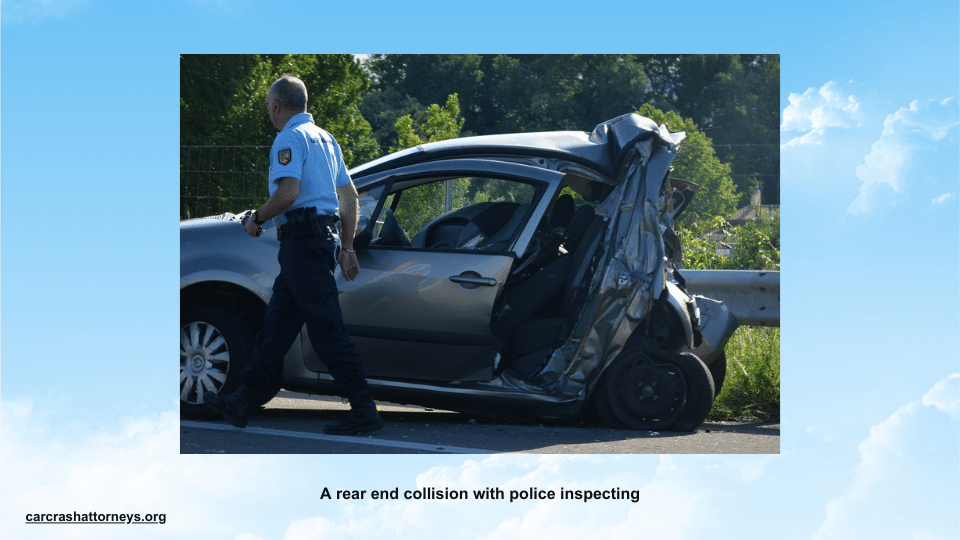Rear End Collision Settlement Examples in 2023 – How To Understand Them
Rear end collisions can be a stressful and confusing experience, leaving victims wondering about the settlement process and how much compensation they might receive. With so many factors at play, such as the severity of injuries, property damage, and insurance company involvement, it’s essential to understand the landscape of rear end car accident settlements. In this comprehensive guide, we’ll explore real-life rear end collision settlement examples, dive deep into the factors influencing settlements, and provide tips to maximize your compensation.
Key Takeaways
Rear-end car accident settlements in 2023 vary depending on the severity of injuries, property damage, and liability.
Professional legal assistance is essential to maximize settlement amounts from rear-end collisions.
Documenting evidence, seeking medical treatment and negotiation with insurance companies are key steps for maximizing a rear end collision settlement.
Real-Life Rear End Collision Settlement Examples
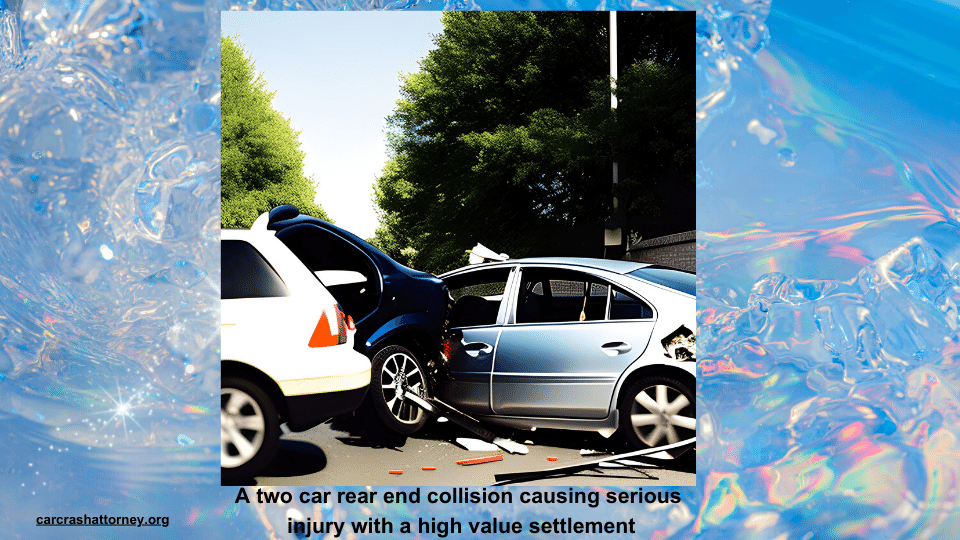
Every rear end collision is unique, and settlement amounts can vary significantly. To gain a better understanding of the potential outcomes, let’s explore some real-life rear-end collision settlement examples, ranging from high-value cases involving severe injuries and significant property damage to low-value cases with minor injuries and minimal property damage.
Consider a rear-end collision in California, which led to a $2.5 million settlement for
High-Value Settlement Example
In a high-value rear end accident settlement, victims may suffer from severe injuries, requiring extensive medical treatment and causing significant property damage. For instance, a victim may have undergone lower back surgery due to the rear end collision and received a substantial payout from the at-fault driver’s insurance company. In such cases, it’s crucial to consult a car accident lawyer to help navigate the complexities of insurance coverage and negotiate a fair rear end accident settlement.
ESIS, the insurance company covering the rental car involved in the accident, initially offered a settlement of $125,000. However, after negotiations and considering the severity of the victim’s injuries, the final settlement amount was likely to be much higher. Securing experienced legal representation in high-value cases is vital to ensure that the compensation mirrors the full extent of the damages and injuries sustained.
Moderate Settlement Example
In moderate settlement cases, victims may experience moderate injuries and property damage, leading to mid-range payouts. For example, in the case of Lydiah Tiffany, the victim received a settlement of $90,000. The typical settlement range for a moderate-value rear end collision can range from $10,000 to $200,000, depending on the severity of the injuries and other relevant factors.
Documenting all medical treatments, injuries, and property damages is a key step in supporting your claim and negotiating a fair settlement. Consulting a personal injury attorney can help you understand the nuances of your case, ensure you receive adequate compensation, and guide you through the settlement process.
Low-Value Settlement Example
In low-value settlement cases, victims may sustain minor injuries with minimal property damage, resulting in smaller payouts. For example, in the case of Lamar, the total settlement amount was approximately $7,400. Compensation for such cases is generally lower due to the lesser extent of injuries and damages.
Regardless of the injury’s severity, it remains vital to see a doctor to document the injury and discuss any potential future symptoms. Additionally, seeking legal counsel is recommended, as a lawyer can help ensure that you receive adequate compensation and navigate any challenges that may arise during the settlement process.
Factors Influencing Rear End Collision Settlements
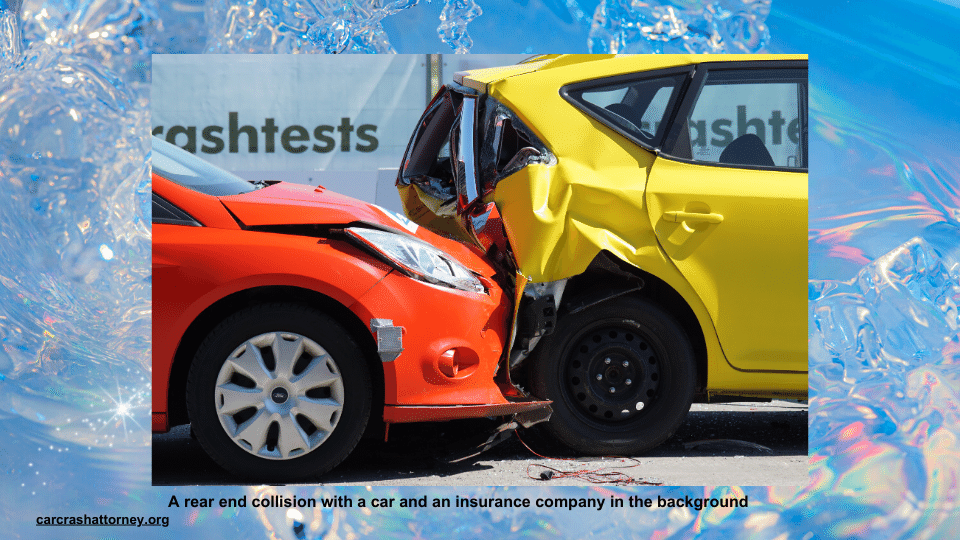
Having examined real-life settlement examples, we will now delve into the factors that influence rear-end collision settlements. The severity of injuries, property damage, and liability all play a crucial role in determining the final settlement amount.
Each of these factors will be examined in detail in the following sections, highlighting their potential impact on your compensation.
Severity of Injuries
The severity of injuries sustained in a rear-end collision directly impacts the settlement amount, with more severe injuries leading to higher payouts. Common injuries resulting from rear end accidents, also known as rear-end collisions, include:
Whiplash
Broken bones
Brain injuries
Abdominal and spinal injuries
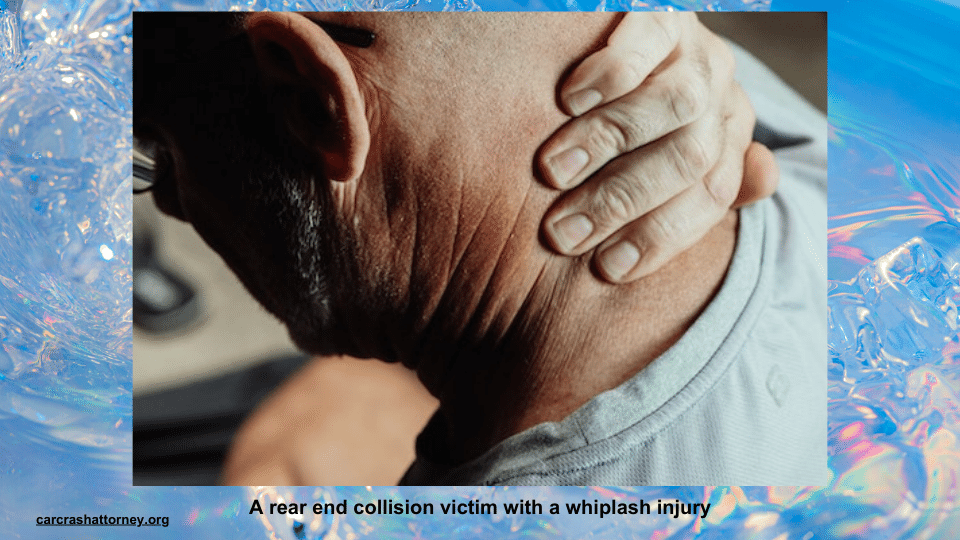
The greater the magnitude of the collision vehicles’ size and velocity, the more hazardous rear-end collisions and car accidents are likely to be.
G-force, a measure of gravitational force that results in the feeling of external pressure when an individual experiences rapid acceleration or deceleration, is an important factor in determining the types of injuries that can occur in a rear-end collisions. Medical records, the impact on daily life, and the duration of recovery can serve as bases for evaluating the severity of injuries.
Documenting the severity of your injuries and the extent of your medical treatment is critical, as this information will factor heavily in calculating your pain and suffering compensation. Consult a personal injury attorney to ensure your injuries are adequately represented in the settlement negotiations.
Property Damage
Property damage caused by the rear-end car accident also affects the settlement amount, with more extensive damage resulting in higher payouts. In rear-end collisions, property damage typically occurs at the rear of the vehicle, affecting the bumper, trunk, and taillights. The cost of repairing the vehicle, as well as any damage to the contents of the vehicle, should be taken into account when evaluating the extent of property damage.
To appropriately assess the settlement, one should:
Document both visually apparent exterior damages and potentially concealed interior damages
Request a copy of the bill for repairs to your vehicle from the company that repaired it
Gather any other relevant documentation to support your claim.
An experienced personal injury lawyer can help you navigate the complexities of property damage claims and ensure that you receive fair compensation for all damages sustained in the rear-end collision.
The Importance Of Liability and Fault In Rear End Collision Settlement Examples
Liability and fault play a crucial role in determining the settlement amount in rear-end car accident cases, as the at-fault party is typically responsible for compensating the victim. In most rear end collisions, the driver who collides with the car in front of them is usually held responsible. However, there are exceptions, such as when the lead driver reverses unexpectedly, their brake lights are not functioning, or they engage in other negligent behavior.
In some cases, the driver who was impacted could be held responsible for a rear-end collision if they acted in an irresponsible manner and made the rear end crash unavoidable for the other driver, or if they switched their car’s gear into reverse and reversed into the vehicle behind them. To establish the liability and fault of the parties involved in a rear-end accident, it’s important to gather evidence, such as photographs of the accident scene, witness statements, and any other relevant documentation.
An experienced car accident attorney can help you determine the liability and fault in rear end accident cases, such as your rear-end car accident, and ensure that you receive the compensation you deserve.
Insurance Company’s Role in Rear End Collision Settlement Examples
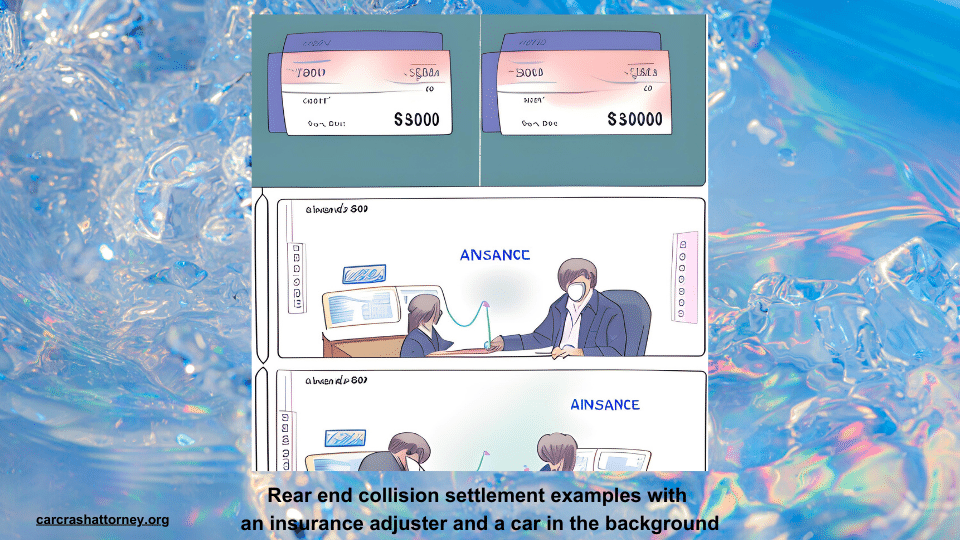
Insurance companies play a significant role in rear-end collision settlements, as they are responsible for assessing the claim and determining the appropriate amount of compensation.
This section discusses the role of insurance companies in rear-end car accident settlements, including the impact of initial settlement offers and policy limits on the final settlement amount.
Initial Settlement Offers
Insurance companies often make initial settlement offers that may be lower than the actual value of the claim, requiring negotiation for a fair settlement. For example, in the case of a truck driver who was rear-ended, the initial settlement offer proposed by Travelers was $25,000. The van driver’s insurance company, in another case, presented an initial settlement offer of no more than $20,000.
One should avoid hastily accepting the initial offer, as it might not sufficiently cover your losses and future expenses related to the accident. To negotiate a fair settlement, provide supporting evidence of injuries and damages and make a counteroffer that is higher than the initial offer.
An experienced car accident lawyer can help you navigate the complexities of negotiating with insurance companies and ensure that you receive a fair car accident settlement that reflects the true extent of your damages and injuries.
Insurance Policy Limits
Insurance policy limits can affect the maximum payout available in a rear-end accident settlement, potentially limiting the compensation received by the victim. The policy limits represent the maximum amount the insurance company is obligated to pay for the claim. If the settlement amount surpasses the policy limits, it may be challenging to obtain the full amount.
It’s important to take into account the defendant’s insurance policy limits when negotiating a settlement, as well as your own insurance coverage, such as uninsured/underinsured motorist coverage, which can provide additional compensation in case the at-fault driver’s insurance is insufficient to cover your damages.
Engaging a personal injury attorney can help you navigate the intricacies of insurance policy limits and ensure that you receive the maximum compensation possible.
Legal Assistance in Rear End Collision Settlement Examples
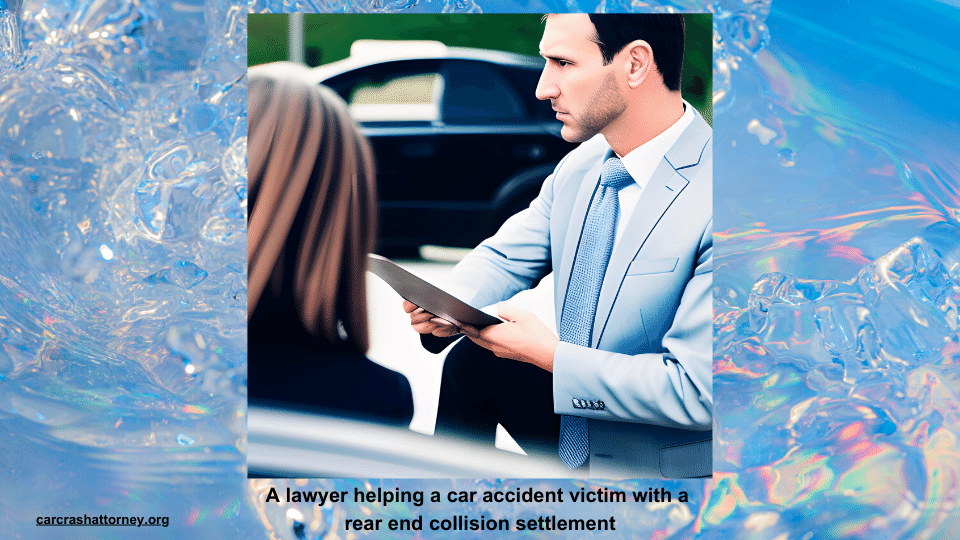
Legal assistance is crucial when it comes to rear-end car accident settlements, as an experienced personal injury attorney can help you navigate the complexities of the settlement process and ensure that you receive fair compensation for your injuries and losses.
This section discusses the significance of legal assistance in rear-end collision settlements, including the optimal time to hire a lawyer and how they can aid in maximizing your settlement.
When to Hire a Lawyer
Engaging a lawyer is advisable when dealing with severe injuries, complex liability issues, or disputes with insurance companies. In cases involving severe injuries, an attorney can effectively represent your interests and work towards obtaining a larger award to cover your losses.
Additionally, a lawyer can help you understand the nuances of your case and guide you through the settlement process, ensuring that you receive fair compensation for your injuries and damages.
In situations involving complex liability matters or conflicts with insurance providers, engaging a lawyer may be particularly beneficial, as they can help you navigate these challenges and ensure that your rights are protected. It’s essential to consult with an attorney as soon as possible following the accident to guarantee that you receive a just settlement and that crucial evidence is preserved.
How a Lawyer Can Help
A lawyer can help you in several ways when it comes to rear-end collision settlements. First, they can gather evidence, such as photographs of the accident scene, witness statements, and medical records, to support your claim and strengthen your case. They can also negotiate with insurance companies on your behalf, ensuring that you receive a fair settlement that reflects the true extent of your damages and injuries.
Additionally, if necessary, a lawyer can represent you in court, advocating for your rights and fighting for the compensation you deserve. With their expertise and knowledge of personal injury law, an experienced car accident attorney can help you navigate the complexities of your case and secure the maximum remuneration for your injuries and losses.
Calculating Pain and Suffering in Rear End Collision Settlements
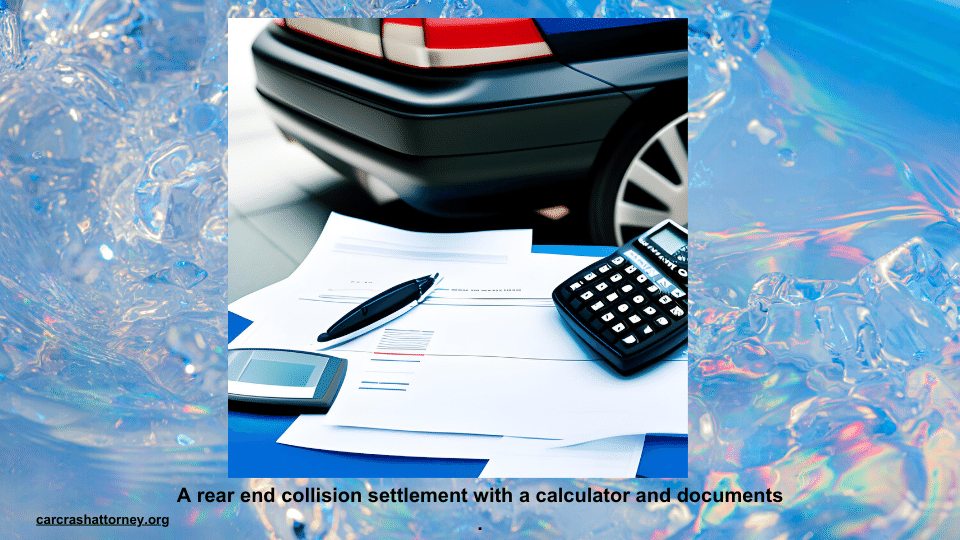
Pain and suffering, as well as medical expenses, are intangible costs that are taken into account when determining settlements for rear-end collisions.
This section delves into the concept of calculating pain and suffering in rear-end crash settlements, including the calculation methods and factors that can influence the compensation amount.
Methods for Calculating Pain and Suffering
There are two primary methods for calculating pain and suffering in rear-end car accidents: the per diem and multiplier methods. The per diem method assigns a daily rate for the pain and suffering experienced by the victim, which is then multiplied by the number of days the victim experienced such distress. For example, if the daily rate is $100 and the victim experienced pain and suffering for 10 days, the total amount of pain and suffering would be $1,000.
On the other hand, the multiplier method involves multiplying the victim’s economic damages (e.g., medical bills and lost wages) by a number (the multiplier) to estimate the victim’s pain and suffering. For instance, if the victim’s economic damages were $5,000 and the multiplier was 2, the total amount of pain and suffering would be $10,000.
The choice between the per diem and multiplier methods will depend on the specific circumstances of the case and the extent of the victim’s suffering.
Factors Affecting Pain and Suffering Compensation
The amount of pain and suffering compensation a victim may receive can be influenced by several factors, including the severity of injuries, the impact on the victim’s daily life, and the duration of recovery. The more severe the injuries and the greater the impact on the victim’s daily life, the higher the pain and suffering compensation is likely to be.
Additionally, the duration of recovery can also play a significant role in determining pain and suffering compensation. The longer it takes for a victim to recover from their injuries, the more compensation they may be entitled to.
It’s essential to document the course of your treatment, working in cooperation with your primary care physician, to ensure that you receive fair compensation for your pain and suffering.
Tips for Maximizing Your Rear End Collision Settlement
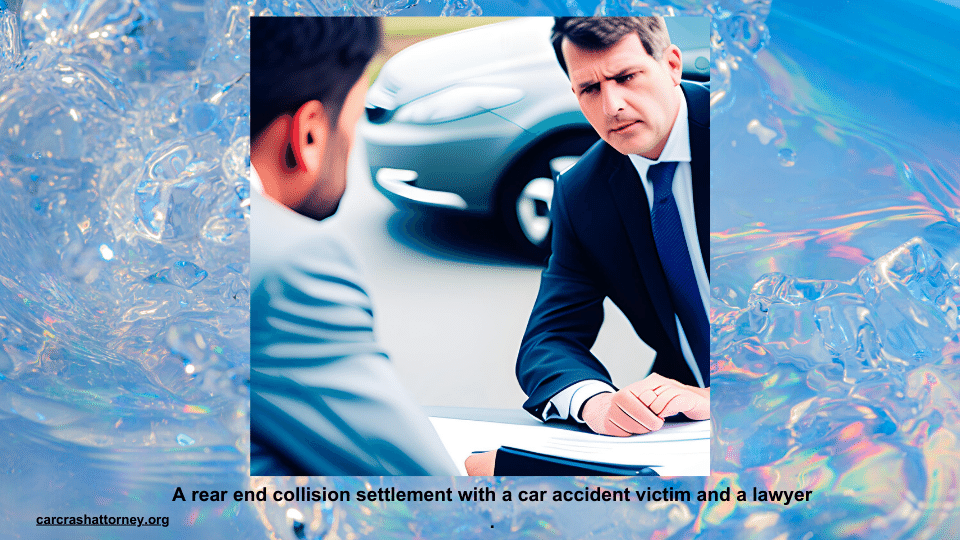
With a clear understanding of the factors influencing car accident settlements and the role of insurance companies and legal assistance, it’s essential to take appropriate steps to maximize your compensation.
This section offers valuable tips aimed at strengthening your case, ensuring the best possible outcome, and securing the compensation you deserve.
Documenting Evidence
Thoroughly documenting evidence is one of the most critical aspects of maximizing your car accident settlement. This includes taking photographs of the accident scene, obtaining contact information from witnesses, and collecting any other evidence that could support your case.
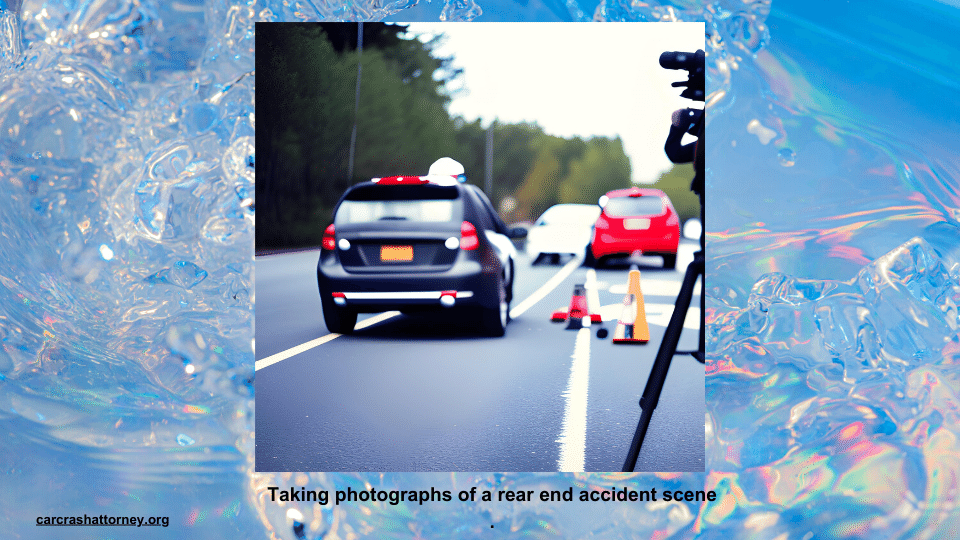
It’s also essential to document your injuries and treatments, as this information will help your attorney negotiate a higher settlement on your behalf.
In addition to documenting the accident scene and your injuries, it’s important to keep a detailed record of all medical visits, treatments, and medications, as well as take pictures of any visible injuries. This documentation will not only help you support your claim but also serve as valuable evidence when negotiating with insurance companies and determining your pain and suffering compensation.
Seeking Medical Treatment
It’s pivotal to seek prompt medical treatment after rear-end collisions for both your health and your settlement claim. Not only will receiving medical care help document the severity of your injuries, but it will also provide evidence to support your claim.
In addition, following your doctor’s recommendations can serve as evidence of the severity of your injuries and bolster your case.

It’s important to consult a doctor as soon as possible after the accident, even if your injuries seem minor. Delaying medical attention could make it more difficult to link your current symptoms to the crash, and insurance companies may use this delay to argue that your injuries are not as severe as you claim. To ensure that you receive the compensation you deserve, make sure to seek medical treatment promptly and follow your doctor’s recommendations.
Negotiating with Insurance Companies
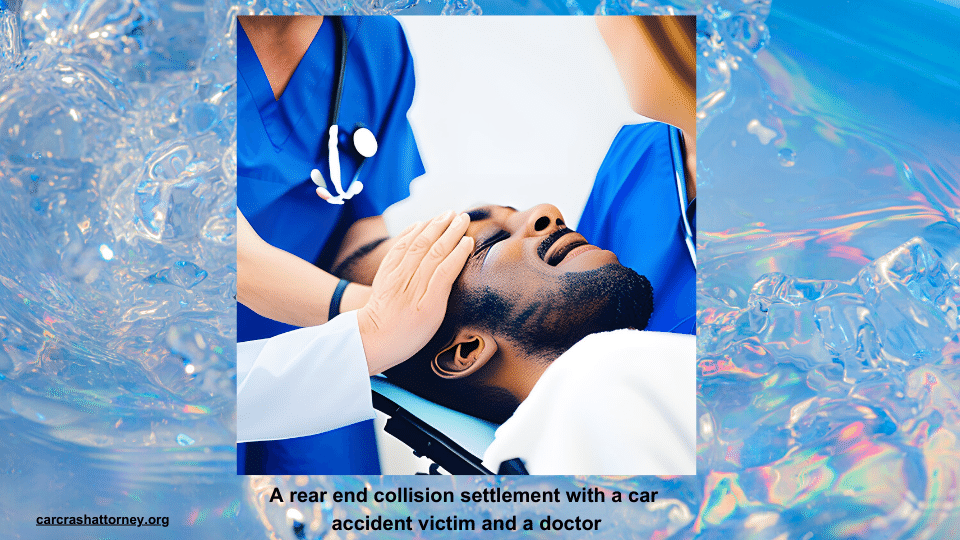
Although negotiating with insurance companies can be challenging, being well-prepared with evidence and a clear understanding of your case can facilitate securing a fair settlement. When dealing with insurance companies, it’s important to:
Be well-prepared with evidence
Have a comprehensive understanding of your case
Be mindful of the insurance policy limits
Consider the liability and fault of the parties involved
One should avoid hastily accepting the initial offer, as it might not sufficiently cover your losses and future expenses related to the accident. To negotiate a fair settlement, follow these steps:
Provide supporting evidence of injuries and damages.
Make a counteroffer that is higher than the initial offer.
An experienced car accident attorney can help you navigate the complexities of negotiating with insurance companies and ensure that you receive a fair settlement that reflects the true extent of your damages and injuries.
Summary
Rear end collision settlements can be complex and challenging to navigate, with various factors influencing the final settlement amount. Understanding the different aspects of rear-end collision cases, such as real-life settlement examples, the role of insurance companies, and the importance of legal assistance, is crucial in securing the compensation you deserve. By following the tips and guidance provided in this comprehensive guide, you can maximize your car accident settlement and ensure a fair outcome for your case.
Frequently Asked Questions
How much is a rear end worth?
The average rear-end collision settlement is estimated to be between $3,000 and $25,000, depending on the severity of your injuries. However, similar accidents may yield substantially more.
What counts as a rear end in an accident?
A rear-end accident occurs when the front bumper of one vehicle collides with the rear end of another vehicle. This type of collision may be caused by inattention, intoxication, road defects, adverse weather and other factors.
What is an example of a rear-end collision?
Rear-end collisions typically involve one driver driving too closely to the vehicle in front of them, either due to speed or a lack of attention, and resulting in a collision with the rear end of the car. Examples include when a driver rolls forward at a low rate of speed into the front driver’s car, or when the at-fault party is driving at a high rate of speed and crashes into a driver that was completely stopped.
Who gets hurt worse in a rear-end collision?
In rear-end accidents, the driver of the rear vehicle is usually at fault and tends to suffer more damage than the front driver. This is especially true when the front car is stationary and the rear vehicle is in motion.
What factors influence rear-end collision settlement amounts?
The amount of a rear-end collision settlement is largely influenced by the severity of injuries, property damage, and liability. Injuries are the most important factor in determining the amount of a settlement. The more severe the injuries, the higher the settlement amount. Property damage is also taken into consideration, as the cost of repairs or replacement.
Further Reading: Rear-End Collisions
Legal Disclaimer: The content provided on carcrashattorneys.org is for general informational purposes only. It is not intended as legal advice, nor does it constitute an attorney-client relationship. The information may not be accurate, complete, or updated when viewing. Carcrashattorneys.org and its authors disclaim all liability for any actions taken or not taken based on the content of this site. Always consult with a licensed attorney in your jurisdiction before making any legal decisions. This website may contain links to other websites. We are not responsible for the content, accuracy, or opinions expressed in such websites, and such websites are not investigated, monitored, or checked for accuracy or completeness by us.

